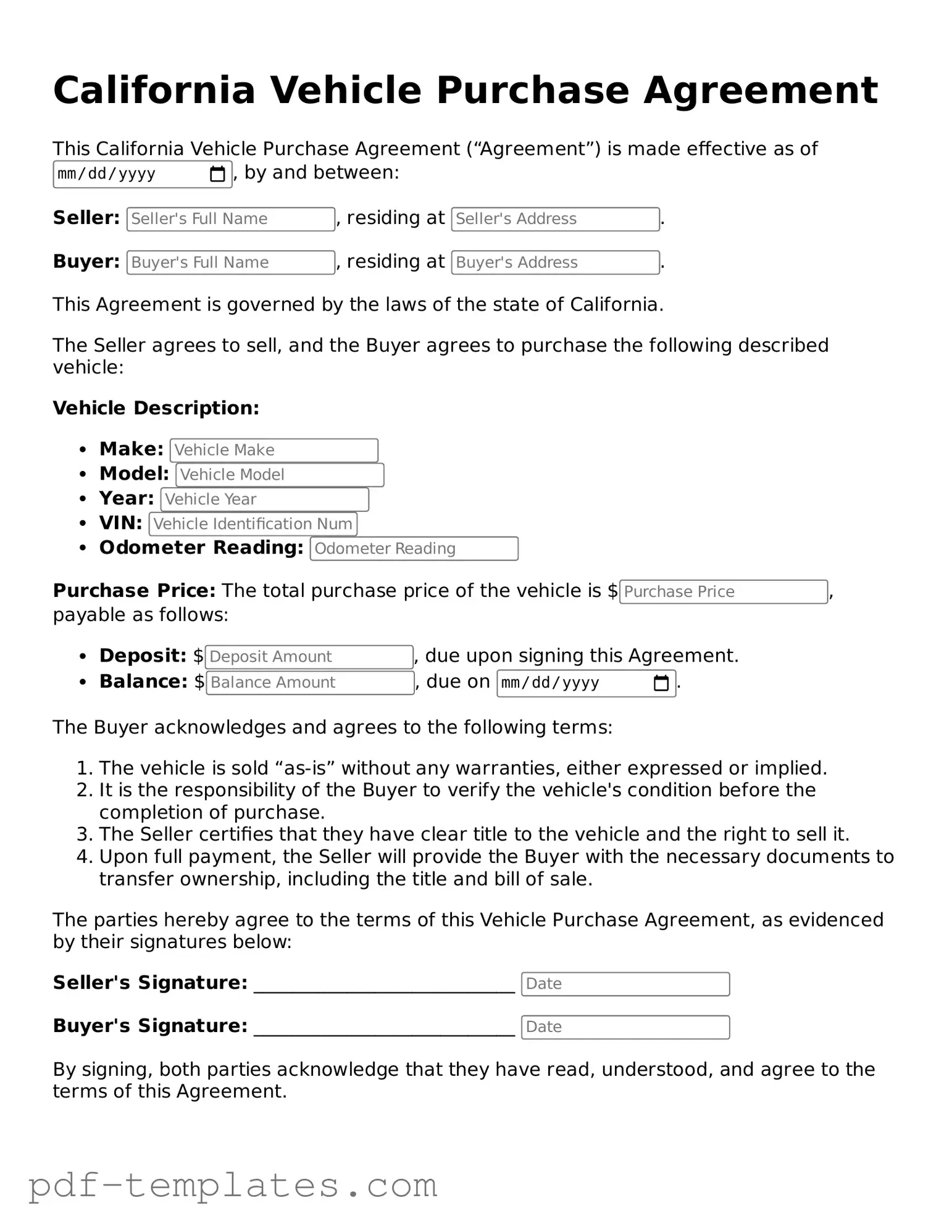The Bill of Sale is a crucial document that serves as proof of a transaction between a buyer and a seller. In California, this document is often used in vehicle sales to formally transfer ownership. Similar to the Vehicle Purchase Agreement, the Bill of Sale outlines the specifics of the sale, including the vehicle's make, model, year, and identification number. It also includes details about the buyer and seller, ensuring both parties have a record of the transaction. This document can be particularly important for registering the vehicle with the Department of Motor Vehicles (DMV).
The Purchase Order is another document that resembles the Vehicle Purchase Agreement. It is commonly used in various sales transactions, including vehicle purchases. A Purchase Order details the specifics of the agreement, such as the price, quantity, and description of the vehicle. While it is more frequently used in business transactions, it shares the same purpose of formalizing the buyer's intent to purchase and the seller's commitment to sell, much like the Vehicle Purchase Agreement.
The Lease Agreement is relevant for those considering leasing a vehicle rather than purchasing outright. Like the Vehicle Purchase Agreement, it outlines the terms of the arrangement, including payment amounts, duration of the lease, and responsibilities of both parties. The Lease Agreement also includes information about the vehicle, ensuring clarity in what is being leased. Both documents serve to protect the interests of the buyer or lessee and the seller or lessor.
The Conditional Sales Agreement is similar to the Vehicle Purchase Agreement in that it allows a buyer to take possession of a vehicle while making payments. This document specifies that the seller retains ownership until the full purchase price is paid. It includes terms regarding payment schedules, interest rates, and what happens if payments are missed. Like the Vehicle Purchase Agreement, it is designed to protect both parties during the transaction.
The Retail Installment Sales Contract is another document that bears similarities to the Vehicle Purchase Agreement. This contract is used when a buyer finances the purchase of a vehicle through the seller. It details the total cost of the vehicle, down payment, and payment schedule, much like the Vehicle Purchase Agreement. Both documents serve to formalize the sale and outline the financial obligations of the buyer.
The Vehicle Title Transfer form is essential in the process of changing ownership of a vehicle. This document is often completed alongside the Vehicle Purchase Agreement. It provides legal proof of ownership transfer from the seller to the buyer. Both documents ensure that the transaction is recorded properly, which is necessary for registering the vehicle with the DMV and for the buyer to obtain insurance.
The Odometer Disclosure Statement is required in many vehicle sales, particularly for used cars. This document provides a record of the vehicle's mileage at the time of sale. Similar to the Vehicle Purchase Agreement, it protects both the buyer and seller by ensuring transparency regarding the vehicle's condition. It helps prevent fraud and provides a clear record that can be referred to later.
The Warranty Deed, while typically used in real estate transactions, shares the concept of transferring ownership. In vehicle transactions, a similar document may be used to outline any warranties or guarantees regarding the vehicle's condition. Like the Vehicle Purchase Agreement, it aims to protect the buyer by ensuring that any claims made by the seller about the vehicle are documented and enforceable.
The Financing Agreement is crucial for buyers who need to borrow money to purchase a vehicle. This document outlines the terms of the loan, including interest rates, repayment schedules, and any collateral involved. Like the Vehicle Purchase Agreement, it is designed to protect the interests of both the lender and the borrower, ensuring that all parties understand their obligations.
Lastly, the Title Application is a document that must be submitted to the DMV when a vehicle is purchased. It is similar to the Vehicle Purchase Agreement in that it contains essential information about the vehicle and the new owner. This application is necessary for registering the vehicle and obtaining a new title in the buyer's name. Both documents are vital steps in the vehicle purchase process, ensuring that ownership is legally recognized.
